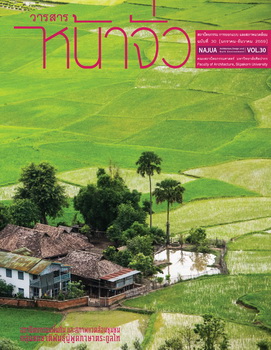เฮือนลื้อกะล่อม: บ้านนายางใต้ เมืองนํ้าบาก สปป.ลาว
Keywords:
ลื้อกะล่อม, สถาปัตยกรรมพื้นถิ่น, เรือนที่อยู่อาศัย, สปป.ลาว, Lue Kalom, Vernacular Architecture, Dwelling House, Lao PDR.Abstract
กลุ่มชาติพันธุ์ “ลื้อกะล่อม” ได้ตั้งถิ่นฐานใน สปป.ลาว มาอย่างยาวนาน และมีถิ่นฐานดั้งเดิมตั้งอยู่ทางภาคใต้ของประเทศจีน หลังจากอพยพลงมาตั้งบ้านเรือนทางภาคเหนือของ สปป.ลาว นั้นได้มีการเคลื่อนย้ายหลายครั้งโดยมีปัจจัยมาจากภัยสงคราม ภัยธรรมชาติ และหาพื้นที่ใหม่ที่กว้างขวางอุดมสมบูรณ์เหมาะสมต่อการเกษตร ในท้ายที่สุด กลุ่มชาติพันธุ์ลื้อกะล่อมจำนวนหนึ่งจึงได้ลงหลักปักฐานอย่างถาวรในพื้นที่ราบเพียงในบริเวณแม่นํ้าลาตอนกลาง ซึ่งแม่นํ้าลาเป็นแม่นํ้าสาขาหนึ่งของแม่นํ้าอู หรือบริเวณที่ราบเพียงใกล้กับแม่นํ้าอู
สำหรับบทความฉบับนี้ได้ลงลึกศึกษาฮูปแบบและการปรับตัวสถาปัตยกรรมชองกลุ่มชาติพันธุ์ลื้อกะล่อมโดยการลงลึกศึกษาเก็บกำข้อมูลทางภาคสนามในพื้นที่บ้านนายางใต้ และในพื้นที่ต่างๆ ตามเส้นทางอพยพและถิ่นฐานอันเก่าแก่เพื่อนำมาศึกษาเปรียบเทียบ ซึ่งได้พบว่า ฮูปแบบเฮือนนั้นสามารถแบ่งฮูปแบบตามช่วงของอายุการตั้งถิ่นฐานและแบ่งออกเป็น 3 ฮูปแบบ คือ 1 ) ฮูปแบบเรือนดั้งเดิมก่อนตั้งถิ่นฐานในบ้านนายางใต้ 2) ฮูปแบบเรือนดั้งเดิมในบ้านนายางใต้ 3) ฮูปแบบเรือนสมัยใหม่ นอกจากนี้ ยังสามารถแบ่งฮูปแบบตามลักษณะกายภาพของเรือน และความเชื่อที่แสดงออกผ่านงานสถาปัตยกรรม และยังพบว่าหลังจากกลุ่มลื้อกะล่อมได้ลงตั้งถิ่นฐานอันมั่นคงในแม่นํ้าลาตอนกลางแล้วนั้น ฮูปแบบหลังคาเรือนมีการปรับตัวเป็นฮูปแบบใหม่โดยได้รับอิทธิพลจากเรือนลาวในหลวงพระบาง
Dwelling Houses of Lue-Kalom: Baan Nayangtai, Mueang Nambak, Luang Prabang, Lao PDR
Vira Anoluc
Faculty of Architecture, Soupanuwong University, Lao P.D.R.
Translation: Kreangkrai Kirdsiri
Faculty of Architecture, Silpakorn University
Originally, Lue-Kalom people lived in the South of China. War, natural disasters, and the search for fertile agricultural land led them to migrate to various places until eventually, a group settled in the area around La River, which is a branch of Ou River, in the northern part of Lao People’s Democratic Republic, and have lived there ever since.
This study looks at the adaptation or transformations in the architecture of Lue-Kalom settlement by investigating and collecting information from Baan Nayangtai and other related sites. Information obtained were then compared with regards to migration route and the different periods of settlement. As a result, findings could be grouped into 3 categories of house-form as follow: 1) original traditional houses; 2) local traditional houses at Baan Nayangtai; and 3) modern houses. Each category can be identified from the architectural features that express the inhabitant’s beliefs. It was also found that after having firmly established their settlement, roof-form of the houses were characteristically influenced by Lao houses in Luang Prabang.





